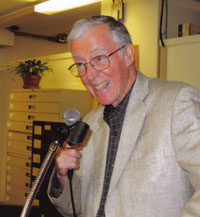
Derek Boogaard, once the most feared enforcer in the NHL, was found dead of an overdose of alcohol and prescription pain killers at the age of 28 earlier in May. If you’re not a hockey fan, chances are you’ve never heard of Boogaard, or enforcers, for that matter. “Enforcer” is the polite term for a hockey goon.
Lots of hockey players fight, but goons are fighting specialists. In theory, a goon’s job is to protect his more agile, goal-scoring teammates from cheapshots by other players who would like to take the star out of the game. As Scott Lemieux notes, some teams have goons that do little but fight each other for the spectacle. Most hockey leagues ban fighting, but the NHL exalts fighting as a tradition. A fight can bring an entire stadium to its feet. Replica jerseys of popular enforcers fly off the shelves.
John Branch of New York Times spent six months piecing together the the life and death of Derek Boogaard, from his hockey-crazed childhood in Melfort, Saskatchewan, to his glory days in the NHL, through his agonizing physical and mental disintegration and lonely death. The multimedia package “Punched Out” transcends sports reporting. This series is an investigative triumph, a compelling piece of science writing, and above all, a the tragic story of a guy who sold his soul to play in the NHL.
Part I: A Boy Learns to Brawl
Boogaard grew up in small town Saskatchewan, the son of a Mountie. Boogaard was a gentle kid who would have preferred scoring goals to busting heads, but his immense size and lackluster skills marked him as a goon in the making. “Like so many Canadian boys, Boogaard wanted to reach the National Hockey League on the glory of goals. That dream ended early, as it usually does, and no one had to tell him,” Branch writes.
Boogaard’s big break came at the age of 15 when he lost his temper as he was being hauled off the ice for an earlier penalty. He pushed off the referee and dove into the opposing team’s bench, swinging. His dad, the cop, was appalled, but a scout was very impressed. That rampage was Derek’s ticket to the big leagues.
Part II: Blood on the Ice
In the second installment, Branch elaborates on the role of the enforcer in the NHL:
Imagine in football, if a linebacker hit a quarterback with what the quarterback’s team believed was too much force. The equivalent to hockey’s peculiar brand of justice would be if those teams each sent a player from the sideline — someone hardly valued for his skill as a player, perhaps rarely used — and had them interrupt the game to fight while teammates and officials stood back and watched. In football, as in most sports, such conduct would end in ejections, fines and suspensions. In hockey, it usually means five minutes in the penalty box and a spot in the postgame highlights.
Branch describes the physical and psychological toll of the enforcer’s job. Boogaard once hit another player so hard that his cheekbone had to be surgically reconstructed. Despite years of boxing lessons, Boogaard was lax about defense. Teammates recall that he’d take several punches for the opportunity to land one good blow. Boogaard was still a young man, but his hands were so mangled from years of bare knuckle brawling that his family wondered how he’d be able to hold a pen when he got old. By his late twenties, he had bulging disks in his back, a shoulder that hadn’t been right since his teens, and a repeatedly broken nose that was excruciating to reset.
Like many NHL players, he became dependent on painkillers to mask the damage he was inflicting on his body and sleeping pills to cope with the gruelling travel schedule. Less dramatically, but more ominously, Boogaard was racking up concussions and hiding them.
Part III: A Brain ‘Going Bad’
Boogaard staggered through the 2009-2010 season in a haze. “His demeanor, his personality, it just left him,” John Scott, a Wild teammate is quoted as saying. “He didn’t have a personality anymore. He just was kind of — a blank face.” He lost the will to fight on the ice and took some bad hits because he wouldn’t return a punch. The team gave him time time off. He drank, swallowed pills by the handfull, racked up huge credit card bills, rented expensive sports cars, and logged more time in drug rehab. On the night of his death, he was just hours out of drug treatment.
Boogaard’s family donated his brain to a team of researchers in Boston who study concussions in sports. He was the fourth dead NHL player to have his brain examined by the research team, and the fourth to be posthumously diagnosed with Chronic Traumatic Encephalopathy (CTE), a disease similar to Alzheimer’s caused by repeated blows to the head. The researchers have found CTE in the brains of over twenty dead NFL players so far. CTE may explain why the formerly goodnatured and conscientious Boogaard behaved so erratically during the last months of his life. The researchers were shocked at the extent of brain degeneration in a relatively young man.
Learning the extent of his son’s brain damage changed Len Boogaard’s perspective on his son’s death. As hard as it was to lose a 28-year-old to an accidental overdose, the brown shadows spreading over Derek’s brain foretold a future that might have been even worse:
The Boogaards learned of the surprising severity of the brain damage. And they heard about the prospects of middle-age dementia.
It was then that Len Boogaard stopped listening. Something occurred to him that he did not expect.
For months, he could not bear the thought of his son’s death. Suddenly, he was forced to imagine the life his son might have been left to live.
The NHL remains officially skeptical about the link between CTE and Boogaard’s career as an enforcer. The league has no plans to change the rules for fighting.
As one CTE researcher observes, it’s hard to know whether Boogaard’s drug abuse accelerated his brain degeneration or vice versa. In a sense, it doesn’t matter. By the time we’re invited to consider this chicken and egg problem, Branch has skillfully established that fighting, orthopedic injuries, pain killers, addiction, and CTE were inextricably linked in Boogaard’s demise. Towards the end, Boogaard liked to hide his pills in colorful plastic Easter eggs and stash them around his apartment. Branch has an eye for these kinds of telling details.
Maybe the drugs made Boogaard’s brain damage worse, but his fights injured him so badly that he needed powerful painkillers to play, and no doubt the brain damage sapped his impulse control in the face of constant access to drugs and booze. It’s a chicken and egg problem, but the NHL is watching this hen house.
To learn more about CTE and contact sports, check out Offensive Play, Malcolm Gladwell’s classic 2009 New Yorker essay about brain damage in the National Football League. Boogaard’s brain is in the same brain bank that Gladwell describes.
Canadians like to think of themselves as more civilized than neighbors to the south. We’ve become accustomed to the idea that professional football players and boxers are damaging their brains in pursuit of athletic glory, but it’s a shock to think of hockey in the same category. Punched Out has prompted a lot of soul searching amongst fans. The series raises questions about what players like Derek Boogaard are asked to endure for our entertainment.
[Photo credit: MattBritt00, Derek Boogaard vs. Steve MacIntyre.]










